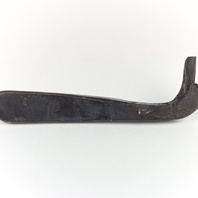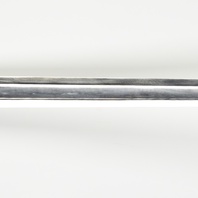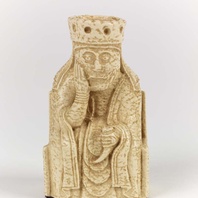
Viking Names
Donisthorpe
Donisthorpe, historically belonging to the Repton and Gresley Hundred of Derbyshire, comes from the Norman male personal name Durand (Middle English genitive singular Durandes) and the Old Norse element þorp ‘outlying farm, settlement’. Place-names containing þorp are thought to be later names, or at least rather longer lived, than those containing the Old Norse element by ‘farm, settlement’ because there are more instances of post-Conquest-type elements combined with þorp than by. Donisthorpe is an example of one of these place-names. Donisthorpe is a joint parish with Oakthorpe and they were both transferred to Leicestershire in 1897. These place-names are close in proximity to Boothorpe and Osgathorpe in Leicestershire demonstrating the density of the Old Norse element þorp across the medieval and modern landscape.
Read More

Blog Post
Unlocking the Meaning of Keys in the Viking Age
A reproduction iron key based on one from Repton, Derbyshire Most keys that have been found are from graves, and were deliberately buried with individuals. The fact that only some people were buried with keys shows that keys had both practical and symbolic functions in the Viking Age. The practical function of keys was to lock locks, as is to be expected. They secured items against access or theft, and their presence indicates that the owner of the key actually had valuables worth locking up. Viking Age keys, padlocks and locks have all been found by archaeologists. The locks and padlocks probably belonged to chests and were used to secure a person’s most important belongings. Chests were used as storage at home and as travelling luggage by sailors going abroad. The chest provided a secure place to keep personal belongings, and was also used as a seat for the rowers. Keys could be decorated, like one from Gjerdal in Norway, which had been decorated with stylized animal heads and geometric ornamentation that dates it to the Viking Age. Keys are found as a part of burial paraphernalia in Scandinavia from the Migration Period through the Viking Age, and were usually made of iron or copper alloy. Although often viewed as primarily grave goods, in reality they have also been found on settlement sites throughout Scandinavia, and as single finds. Received wisdom states that they are most commonly found in women’s graves, and occasionally in men’s graves. However, they are not a common find overall. Only a small number of keys have been found compared to the large number of excavations undertaken. Most importantly, this applies to graves, where Berg (2015, 130) notes that of 6000-8000 graves excavated in south-east Norway only 117 contained keys. She also shows that keys are not a predominantly female accessory, as is usually stated. The Museum of Cultural History in Oslo notes that approximately 75 copper alloy keys and 170 iron keys of Viking Age date have been found in south-east Norway alone. The copper alloy keys are all different, showing that they were not mass-produced, but rather cast individually. Moulds for keys and smiths’ tools have been found during the excavations at Kaupang in Norway, providing the key to understanding how keys were made. Keys had symbolic value which has most often been taken to indicate the social function of the bearer. As items that provided access and closed it off, they indicated that the bearer had these powers too. This symbolic value has been most associated with women, largely because medieval law codes such as Borgartingslova (the Borgarthing Law) which dates from the twelfth or thirteenth century, identify keys ‘as a signifier for the key-bearer, sometimes described as a woman or housewife’ (Berg. 2015, 127). In the Eddic poem Þrymskviða Thor must dress up as Freyja. Part of his disguise is a set of keys hanging from his belt leading to the suggestion that Freyja may have been particularly associated with keys as a symbol of her domain. This image of powerful women controlling access to the house has led to an enduring image of the Viking Age matriarch wearing keys on her belt or hanging from a brooch to show that she was the gatekeeper in the household. However, this raises the question of what keys are doing in men’s graves, as in the case of Grave 541 at Repton, Derbyshire. Norse laws from the medieval period demonstrate that keys symbolised control over the household, a female area of power, and reinforce this idea. Given that keys symbolized power, ownership and control of access, it is likely that keys in men’s graves are indicators of their status as owners too. They may not have carried them in life, but keys as grave goods symbolise their power after death. Beyond simple interpretations of keys indicating ownership, Pantmann (2014, 52) suggests that keys had a cultic role in pagan Scandinavia. The concept of the ‘kloge kone’ or ‘wise woman’ may have been symbolised by keys, because keys have a universal symbolic value indicating knowledge, power, and insight. In this role, they are associated with Freyja and thus childbirth, the afterlife (Freyja receives half of those slain in battle into her hall Sessrúmnir), and female leadership, a role that is closely associated with the role of matriarch of a household. Berg (2015, 127) notes that the connection between keys and childbirth is that the keys symbolically unlock the womb or loins to ensure a successful birth. Keys are also associated with Christianity. The triquetra found on some keys may be associated with the Holy Trinity, but may also be a pre-Christian symbol of fertility and motherhood (Berg, 128). The focus on keys as symbols of women’s power is not supported by the archaeological evidence, so it is likely that keys are not symbolic of the housewife alone. However, it is noteworthy that decorated bronze keys are almost exclusively linked to women while iron keys are not (Aannestad. 2004, 80). The fact that keys were buried with certain people is a clear indicator of symbolic significance; the dead are buried with items that are important to them or to those that buried them. Those items gain significance by being chosen to be included as grave goods. Thus keys had symbolic significance, and it may have been related to power and access. This is supported by their rarity as finds, indicating that they belonged to the few, not to the many, and it is likely that those few were the ones who had wealth or treasures that needed locking away. Keys are symbols of wealth and access to power, and perhaps symbolise the ability to affect one’s environment through ritual action (Berg. 2015, 132), but their use as symbols is nuanced and may represent different things at different points in the Viking Age, and in different places within the Viking diaspora. As a result, unlocking the meaning of keys in the Viking Age is not simple. Further Reading: Aannestad, Hanne Lovise. 2004. “En nøkkel til kunnskap – Om kvinneroller i vikingtid”. Viking. Berg, H. L. 2015. “’Truth’ and reproduction of knowledge. Critical thoughts on the interpretation and understanding of Iron-Age Keys”. In Marianne Hem Eriksen, Unn Pedersen, Bernt Rundberget, Irmelin Axelsen and Heidi Lund Berg (eds). Viking Worlds: Things, spaces and movement. Oxbow Books: Oxford. Pantmann, Pernille. 2014. “Nøglekvinderne” in Kvinner i vikingtid. Ed. by Nancy Coleman and Nanna Løkka. Scandinavian Academic Press: Oslo. Pp 39-56.
Read More

Blog Post
Slithering Swords in the Viking World
Reproduction of Viking Age sword from Repton by Adam Parsons Forget Vikings and The Last Kingdom – the most pulsating depictions of Viking Age battle appear in early medieval Scandinavian poetry. Here, armies transform into elemental forces and fierce creatures, clashing together in a mass of noise and light. Popular in this imagery is the likening of swords to snakes, with poets styling these weapons as ‘wound snakes’ and ‘battle snakes’ that bite at their enemies. This was not just poetic flourish. Real Viking swords also had something of the snake about them. Their pattern-welded blades writhe with sinuous designs, their hilts with looping serpents. Scale-like panels encrust the heavy hilts of Petersen’s Type D swords; one from Trælnes, Norway even has dark diamonds on a brighter background, mirroring the dark-on-light streak along an adder’s back. Similar designs were made with inlaid wire on other swords. It is even tempting to ponder whether coiled-up blades in Viking burials evoked the posture of resting snakes. How and why did this union between swords and snakes come about? Well, both are long, thin, bulbous at one end and tapered towards the other; they are glossy with mottled markings; both shed their skin (or scabbard); they weave about and bite when threatened. This would be an elegant explanation if snakes were just ‘snakes’, shall we say; but in Viking Scandinavia, serpents held immense symbolic significance. They permeate Scandinavian cosmology, from the ‘world serpent’ Jǫrmungandr to Óðinn using a snake’s form to steal the mead of poetry. Clearly, poets did not just liken swords to snakes because they looked a bit similar. So, what was going on? Poets often paired snakes with key symbols of power and status in the Viking world, namely arm-rings, gold and ships. Swords behaved similarly in Viking thought, so it is perhaps no surprise that snakes dominate their description and decoration. But the ambiguity surrounding snakes may also have been a factor. In Norse mythology, serpents represented both order and destruction (Jǫrmungandr binding the world together, then running rampant at Ragnarǫk). Similarly, in the poem Rígsþula Heimdallr’s highest born child has ‘piercing’ eyes ‘like a young snake’s’, but in Skirnismál the ‘shining serpent’ is ‘hateful to men’. Such contrasting feelings also applied to swords, which were instruments of order (protecting one’s self, comrades, kingdom) and chaos (destroying those of your enemy). This tension is captured by a Valkyrie in the poem Helgakviða Hjǫrvarðssonar, who knows a sword that is ‘better than all the rest’ – but it is also ‘the evil one among battle-needles’. This verse may encapsulate why swords and snakes intertwined in Viking minds: two powerful beings that were at once alluring and deadly. References Brunning, S., ‘”(Swinger of) the Serpent of Wounds”: Swords and Snakes in the Viking Mind’ in Representing Beasts in Early Medieval England and Scandinavia, ed. by Michael D. J. Bintley and Thomas J. T. Williams (Woodbridge: Boydell, 2015)
Read More

Blog Post
Viking Board Games
A reproduction of a queen for chess found on the Isle of Lewis, Outer Hebrides. Jarl Rögnvaldr Kali Kolsson of Orkney composed a poem describing his nine skills in the first half of the twelfth century. These were all the skills that a member of the aristocracy in medieval Orkney and Scandinavia would have been expected to know, to be considered cultured and socially adept. Among these skills, he included board games (Old Norse tafl). It is possible that he meant chess, because chess was becoming fashionable in the courts of Europe at this time. However, Rögnvaldr could have been referring to any number of board games: Old Norse tafl refers to board games in general, rather than to one specific one. It is related to the Latin word tabula and the modern English word ‘table’. In its most general sense it refers to a flat surface, hence the board of a board game. The Old Norse word tafl is occasionally compounded with other words to specify more closely which game is meant; for example, Old Norse skáktafl means chess. Rögnvaldr lived shortly after the end of the Viking Age, but it is highly likely that the Vikings considered knowledge of these games to be an important part of a man’s social skills, as is suggested by episodes where they are depicted playing board games in the sagas, and the cultural context in which board games were played as recreation remained substantially the same from the Viking Age into the medieval period. Hnefatafl (often called ‘King’s Table’ in English) is the board game most commonly associated with the Viking Age by modern people. It can be traced back to games played in Imperial Rome from at least the first century AD under the name Ludus latrunculorum (the game of the little thieves). These games were made popular throughout Europe under the Roman Empire. They were only replaced when chess arrived in Europe from India. Hnefatafl is an asymmetric game where the defender has to try to move their king off the board while the attacker has to capture the king. Moves are made orthogonally in the same manner as a rook in chess. There are many variants of this game, using different sized grids but all have an odd number of rows so that the king may be placed in the central square. There are no detailed descriptions in Scandinavian sources that permit reconstruction of the rules. Instead the rules used now have been developed from the rules for Tablut which Carl Linnaeus wrote down in Latin in 1732. Linnaeus’ description of the game was based on his observations of how it was played among the Sámi. It is fortunate that he chose to visit the Sámi when he did, because Tablut was becoming less popular at that time; the younger people preferred card games to board games. There are gaps in the rules that Linnaeus recorded, and modern rules have been adapted to fill those gaps, and to balance the game. This has resulted in a number of variants of hnefatafl in use today. A reproduction of the Coppergate game board featuring reproduction gaming pieces Hnefatafl is attested in written sources that are supported by archaeological evidence. Ragnars saga loðbrókar mentions that Sigurðr and Hvítserkr played it, and in Morkinskinna, one of the histories of the Norwegian kings, Sigurðr Jerusalem-farer, king of Norway from 1103-1130, boasts how much stronger he is than other men, but his brother Eysteinn immediately puts him down by saying “Yes, but I’m better at hnefatafl than you!” Gull-Þóris saga mentions that two women played hnefatafl, so it was obviously socially acceptable for women to play too. Of course, while hnefatafl was a pastime, it did not always end well. Þorbjörn Hook was playing halatafl, a variant of hnefatafl that used pieces with pegs in the base that could then be inserted into holes in the board, thus making it a perfect travel game. His stepmother thought this was not a good use of his time, so she grabbed one of the pieces and threw it in his face, gouging his eye out in the process so that it hung down on his cheek. There is ample physical evidence for these games. Game boards of a type that Rögnvaldr would have known have been found in Viking Age boat burials like the Gokstad ship (c. 900) where a double-sided board was found. On one side it has a grid that may have been for hnefatafl while on the other is a grid for Nine Men’s Morris, another ancient game that was probably popularised throughout Europe under the Roman Empire. A fifteen by fifteen gridded board was found in the Coppergate excavations in Viking Age York, pointing to a variant of hnefatafl being played there. The Ballinderry gaming board with its drilled peg holes may be a board for a halatafl variant. The literary evidence also suggests that the defender’s pieces were usually red, while the attackers were white, although archaeological finds suggest a broader range of colours. Dozens of playing pieces from Viking board games have been found on archaeological sites, including the Viking camps at Repton and Torksey in England, where invading Vikings presumably whiled away their time playing these board games. Some of these were on display in the Danelaw Saga exhibition at the University of Nottingham. The Portable Antiquities Scheme has also recorded a broad spread of gaming pieces throughout the Danelaw. These pieces are usually roughly conical in shape and could have been cast very quickly and easily in simple moulds. Gaming pieces could be made of glass, like some found at Birka in Sweden, amber, liked those from the Skamby ship burial, or of horn or antler. Some of the Lewis chess pieces may actually have served double function as tafl pieces too. Analysis of gaming pieces and their deposition in graves suggests that each person was not buried with enough gaming pieces to provide both sides in a tafl game. Instead, they could provide a force for the attacker on an 11×11 board, on average, or the defender on a board as large as 15×15 squares. This suggests that Vikings brought their own force to the table rather than one person providing both sides. One final piece of evidence for board gaming is the depiction of two people playing a game and drinking horns of ale on a runestone (Gs 19) at Ockelbo in Sweden. The original stone has been destroyed but a replica stands on the spot now and shows clearly that the game board had the centre and the four corners marked to show where the hnefi or king stood at the start and where he had to escape to. Sore losers So, how did these games go down at parties? Óláfs saga helga (Chapters 152-53) in Heimskringla (pdf link) relates the tale of how one game played out at a feast at Roskilde in Denmark. Knútr the Great, king of England and Denmark, and he who tried to turn back the waves, was asked by his brother-in-law if he would like to play a board game. Knútr accepted but played badly. He was in a foul mood anyway, and got into a worse mood when Úlfr checked one of his pieces. He took his piece back, saying that he would make a different move instead. Úlfr got angry and tipped the board over, before storming out after they exchanged insults. The next morning, Knútr was getting dressed when he told his servant boy to go and kill Úlfr. The boy returned saying that Úlfr was in the church so he could not do it. Next Knútr told a Norwegian called Ívarr to kill Úlfr. Ivarr went into the church and ran Úlfr through with his sword. He returned to Knútr and told him the news. Heimskringla tells us that Knútr said to Ívarr “You have done well” but I prefer to imagine Knútr saying instead, “Checkmate!” If you are interested in trying hnefatafl cheaply, Cyningstan has a number of print-and-play hnefatafl variants.
